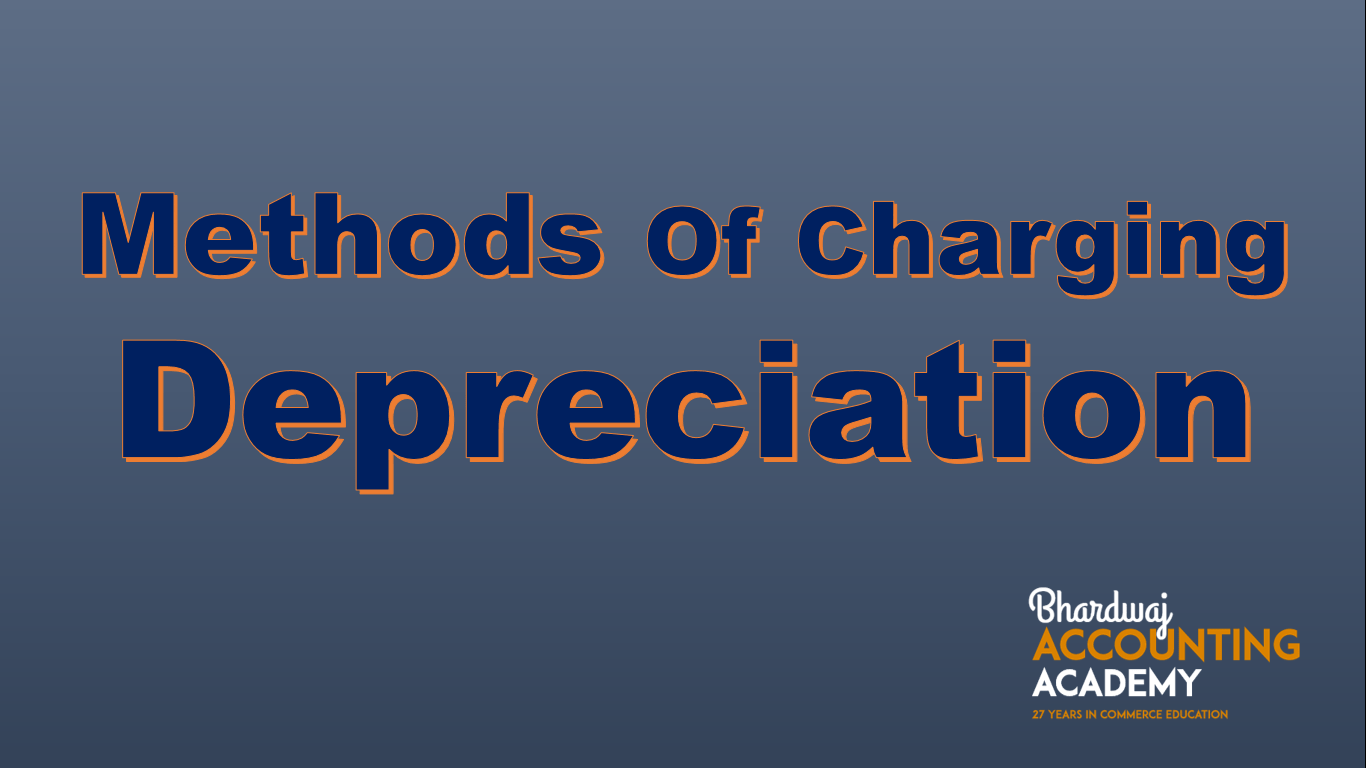Table of Contents
Methods of Charging Depreciation
Methods of Charging Depreciation
There are several methods of charging depreciation on fixed assets, some of the important ones are as follows:
1. Fixed Instalment Method or Straight-line Method Or Equal Instalment Or Simple Method of depreciation,
2. Diminishing Balance Method Or Reducing Balance Method Or Written Down Value Method,
3. Annuity Method,
4. Depreciation Fund Method,
5. Insurance Policy Method,
6. Revaluation Method Or Annual Valuation Method,
7. Machine Hour Method,
8. Depletion Method Or Production Unit Method,
9. The sum of the Year Digits Method,
10. Distance Method,
11. Double Declining Balance Depreciation Method
Methods of Charging Depreciation,
Fixed Instalment Method
1. Fixed Instalment Method or Straight-line Method Or Equal Instalment Or Simple Method of depreciation:
The fixed instalment method refers to the method in which depreciation is calculated every year on the original cost of the asset, in this method the amount of depreciation remains the same every year. It is also known by the names of the straight-line method, simple method of depreciation, original cost method, equal installation method etc. In this method, the value of the asset becomes zero or equal to the scrap value at the end of the life of the asset. The calculation of depreciation in this method is very simple.
Features of Fixed Instalment Method:
1. Depreciation is charged every year on the original cost of the asset.
2. The amount of depreciation remains the same every year.
3. In this method the assets can be written off to zero.
4. The value of the assets decreases at the same rate every year.
5. The residual value is taken into account while computing the depreciation.
6. The calculation of depreciation under this method is very simple, hence the method is widely popular.
7. Once the amount of depreciation is calculated, the same amount is written off as depreciation every year.
Calculation of Annual Depreciation in Fixed instalment method:
1. While the cost of the Assets and the estimated life of Assets is given, the annual depreciation is calculated by the following formula:
Example 1: A Machinery is purchased on 1st January 2020 for ₹5,00,000, the estimated life of the Machinery is 10 years, the books are closed on 31st March every year. Depreciation is charged on fixed instalment method. Calculate annual depreciation.
Annual depreciation=₹5,00,000/10
Annual depreciation= ₹50,000
2. While the cost of the Assets, estimated life of Assets and scrap value of assets is given, the annual depreciation is calculated by the following formula:
Example 2: A Machinery purchased on 1 January 2019 for ₹6,00,000, the estimated life of the machinery is 11 years and the residual value is estimated at ₹50,000. the books are closed on 31st March every year. Depreciation is charged on fixed instalment method. Calculate annual depreciation.
Annual depreciation=₹6,00,000-50,000/11
Annual depreciation= ₹5,50,000/11
Annual depreciation= ₹50,000
3. While the cost of the Assets and rate of depreciation is given, the annual depreciation is calculated by the following formula:
Example 3 : A Machinery was purchased on 1st January 2019 for ₹9,00,000, ₹1,00,000 were spent in setting up the Machinery. The books are closed on 31st March every year. Depreciation is charged at the rate of 10% p.a. by the fixed instalment method. Calculate annual depreciation.
Annual depreciation=(₹9,00,000+₹1,00,000)×10/100
Annual depreciation=₹10,00,000×10/100
Annual depreciation= ₹1,00,000
Example 4: X-Company Ltd purchased A Machinery on 1st April 2020 for ₹8,50,000, Installation Expenses paid ₹1,20,000 and freight paid on Machinery ₹30,000. The books are closed on 31st March every year. Depreciation is charged at the rate of 12% p.a. by the fixed instalment method. Calculate annual depreciation.
Annual depreciation=(₹8,50,000+₹1,20,000+₹30,000)×12/100
Annual depreciation=₹10,00,000×12/100
Annual depreciation= ₹1,20,000
Advantages and Disadvantages of Fixed Instalment Method:
| Advantages | Disadvantages |
|---|---|
| 1. Simple to calculate – The same amount of depreciation is charged every year, so it is easy to understand and apply. | 1. Ignores actual use – Whether the asset is used less or more, the depreciation remains the same. |
| 2. Equal charge every year – A fixed amount is written off annually, which makes the burden on profit and loss account uniform. | 2. No interest on capital – It does not consider the interest lost on money invested in the asset. |
| 3. Easy to compare profits – Since depreciation is the same every year, comparison of profits from one year to another becomes easier. | 3. Not suitable for wasting assets – Assets like machinery, vehicles, etc., lose more value in the early years, but this method charges equal depreciation. |
| 4. Useful for fixed benefit assets – Best for assets like buildings and furniture which give equal benefit during their life. | 4. Overstates profit in later years – As assets grow older, repairs and maintenance increase but depreciation remains constant, so profits appear higher. |
| 5. Certainty in planning – Business can plan future expenses and profits easily because depreciation is predictable. | 5. Scrap value may not be accurate – The method may not show the true market value of the asset at the end of its life. |
Depreciation MCQs with solved answer
Methods of Charging Depreciation



